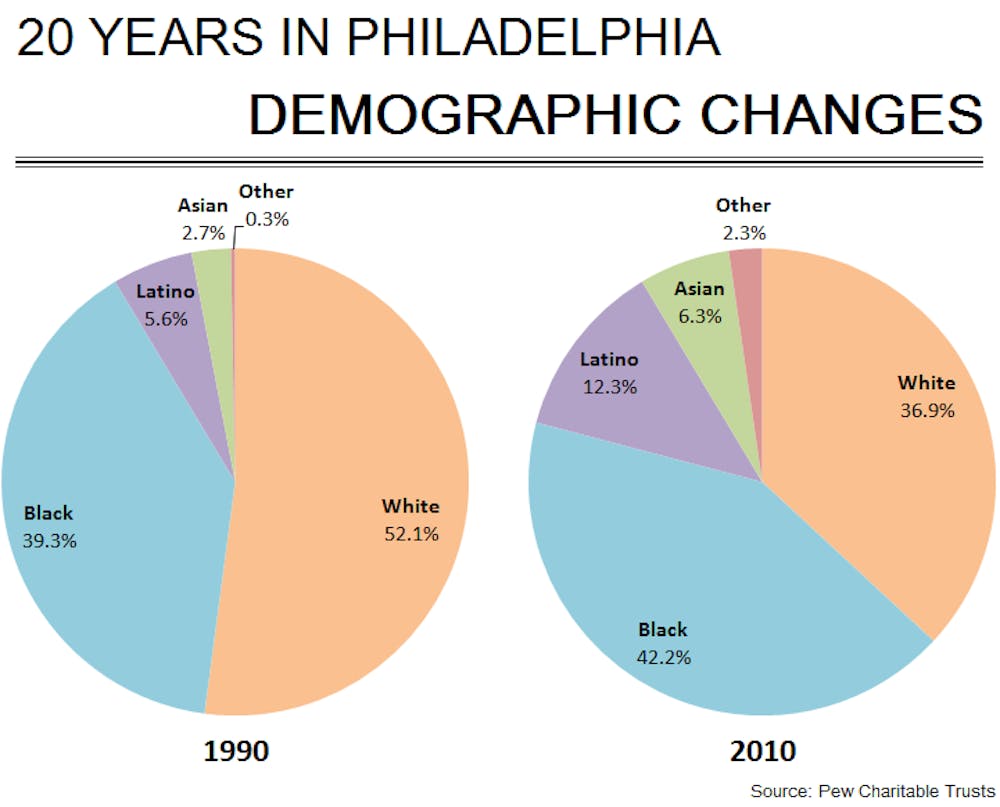
Philadelphia has seen significant racial and ethnic changes over the past two decades, according to a recent study.
The report discovered that nearly a third — 31.9 percent — of the Philadelphia’s non-Hispanic white population left the city between 1990 and 2010, according to an examination of census data from those years by the Pew Charitable Trusts’ Philadelphia Research Initiative.
Philadelphia’s African-American population grew by 3.3 percent in the past 20 years, with the population shifting from its core areas in North and West Philadelphia to new sites such as Southwest Philadelphia and Overbrook.
The city’s Asian and Hispanic populations showed the most dramatic changes, rising by 127 percent and 110 percent, respectively. These increases reflect national trends; throughout the country, the Asian and Hispanic populations rose 114 and 125 percent, respectively.
University City, too, saw sharp rises in the Asian population, at 104 percent, and the Hispanic population, at 84 percent. The white population held relatively steady and the black population decreased by 14 percent.
Domenic Vitiello, Assistant Professor of City Planning and Urban Studies, was not surprised by the changes. “That’s really nothing new,” he said. “It’s been happening since 1952. People always leave cities in the aggregate and they draw in replacement populations of immigrants or internal migrants.”
He added, “I don’t think anything’s particularly different in terms of what drives people to leave, whether it is taxes, schools, or better economic opportunities.”
The research findings showed positive trends overall, said Eugenie Birch, Professor of City and Regional Planning and Co-director of the Penn Institute for Urban Research.
“It is very exciting news because, for many years, Philadelphia has been trying to attract new populations to the city. The increase of the Asian and Latino populations shows that the city’s [de facto] policy to attract immigrants is succeeding,” she said.
Larry Eichel, author of the study and Project Director of the Philadelphia Research Initiative, shared similar sentiments.
“One thing Philadelphia has been criticized for in the past is that it has been slow to welcome immigrants unlike cities such as Chicago and New York,” he said. “What these data show is that over the past 20 years, we are catching up.”
Birch noted a trend of increased commercialization in the Philadelphia neighborhoods that saw population growth, which suggests that the two phenomena are related.
The West Philadelphia community as a whole has changed drastically over the years, Birch said. When she began teaching at Penn in 1998, neither the Schuylkill River Park nor the trail leading to the Philadelphia Museum of Art existed.
As for the University City neighborhood that surrounded Penn’s campus, Birch recalled that there were no retail spots or restaurants like the ones that line 40th and Walnut Streets today.
“The [Penn] Bookstore — that didn’t exist. The movie theater and the Fresh Grocer weren’t there. The neighborhood was inward-looking and there were not many stores on Walnut,” she said, adding that the streets were “barren land.”
Birch also mentioned that education has greatly impacted ethnic and racial changes, particularly in West Philadelphia.
“The construction of the Penn Alexander School has had the effect of attracting families to stay in West Philadelphia — families who might otherwise have moved out to find better schools,” she said. Birch also noted that the school, which receives financial support from Penn, has helped to add more value to the real estate in West Philadelphia and consequently drawn new people to the area.
The Pew study was conducted in conjunction with the Metropolitan Philadelphia Indicators Project at Temple University.
By using data from different zip codes, Eichel was able to observe the population changes in greater detail. Eichel highlighted the notion of Philadelphia being “a city of neighborhoods” and said that because this allowed for striking population changes to be seen at the neighborhood level, using zip codes in his research made it more effective.
Birch agreed with the effectiveness of the research, saying the study was “excellent in showing the big trends.” She added that she would also like to see “research on the different age profiles and household formations” of the various ethnic and racial populations.
The Daily Pennsylvanian is an independent, student-run newspaper. Please consider making a donation to support the coverage that shapes the University. Your generosity ensures a future of strong journalism at Penn.
DonatePlease note All comments are eligible for publication in The Daily Pennsylvanian.








